Growing radishes at home
Bright colors of radish pleasantly pleasing to the eye, crisp structure, sweet-bitter taste, seasoned with young herbs in a salad, stimulates appetite, improves mood, enriches the body with volatile and vitamins. You can grow radishes at home, on the balcony or windowsill, delighting your home with a spring mood all year round.
The origin and description of the culture
Latin radish means "root". East Asia and the Mediterranean are the birthplace of a famous vegetable. More than three millennia grow radish in China. The ancient Greeks honored Apollo, presenting its fresh fruits on a golden platter. The Italian merchant traveler Marco Polo brought the vegetable to Europe.
Did you know? At the International Space Station, radishes were grown for a short growing season and the possibility of eating fruits and leaves. An annual root crop of the cabbage family, genus ─ radish. Round or oblong, pungent, juicy, dense texture. By selection of radish varieties of red, violet, white, pink, yellow shade were bred. There are red fruits with white tips, white with pink flesh.
The taste of radish is affected by the presence of mustard oil. The root crop is eaten whole, in salads, in combination with other vegetables: cucumbers, tomatoes, herbs. From young non-prickly leaves, you can cut a vitamin salad with the addition of spring greens and the actual radish fruits.

Is it possible to plant radishes at home?
The general opinion that a vegetable grows only in the spring, in a greenhouse or in open ground, has long been refuted by vegetable growers who know how to grow radishes at any time of the year at home. The cold-loving root crop will require compliance with the rules:
- maintaining the right temperature;
- proper lighting;
- high fertility soil;
- optimum humidity of the soil and air.
Choosing a place to grow a house
Temperature is one of the main conditions for obtaining a high-quality radish crop at home. Optimal indicators at different stages of vegetable development:
- before emergence ─ +18 ... + 20 ° С;
- seedlings grow better at +6 ... + 8 ° C;
- fruit formation phase: during the day +12 ... + 16 ° С, at night +8 ... + 10 ° С.

Did you know? Nissan Tamir, a farmer from Israel, grew a 10 kg radish.
The best varieties of radish
Early ripening varieties bred by breeders are best suited for indoor cultivation:
- Heat ─ ripening period of about 3 weeks. It is pain-resistant, does not drive out arrows. Raspberry-red fruits, flesh is white, juicy.
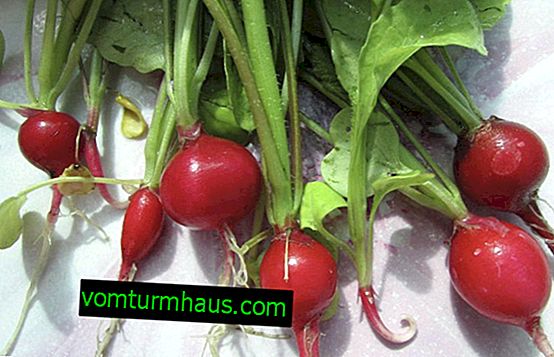
- 16 days ─ super fast ripening variety. Rounded, juicy fruits of bright red color with delicate pulp, mass ─ 25 g.

- French breakfast ─ ripens in three weeks. Raspberry-red cylinders up to 10 cm long. The tips are white. The pulp is juicy, dense, white. Resistant to the formation of arrows. Unpretentious in leaving.
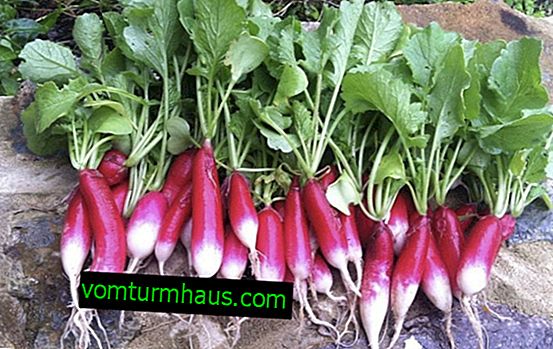
- Ruby ─ has good germination. Ripens in three to four weeks. Fruit shape ─ ellipse, round. Weight ─ up to 30 g. Juicy soft pulp with a mild spicy taste.
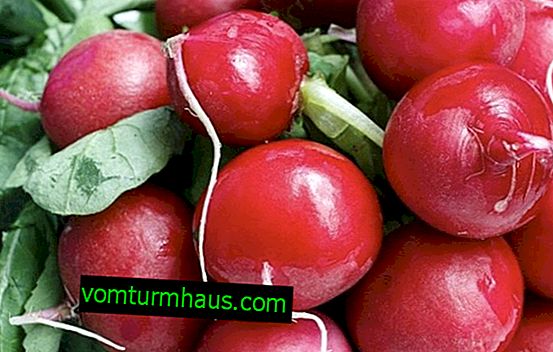
- Sax - ripens in 25 days. Round red fruits with a flat head, weight 9–11 g. The flesh is juicy, islet, white;
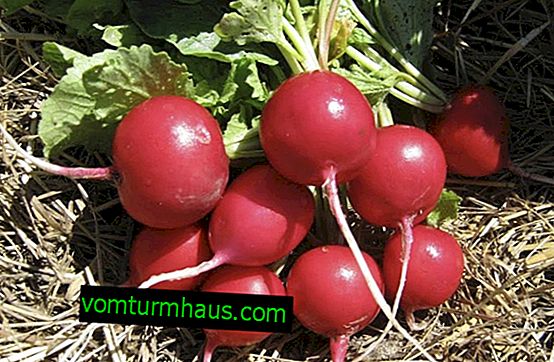
- Champion - resistant to the formation of the shooter variety, ripens 25 days after the first leaves. Oval-rounded fruits weighing 20 g have a juicy, spicy taste.
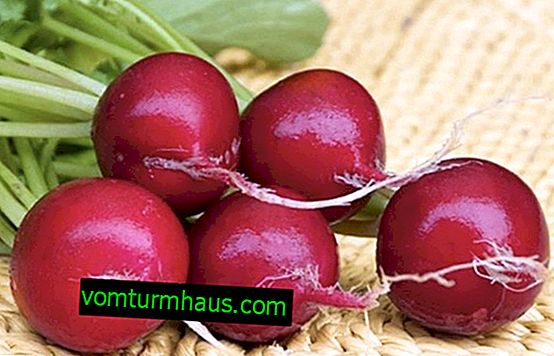
- Presto is a variety of ultra fast ripening ─ 16 days. The fruits are bright red, round, with white flesh. It is characterized by unpretentiousness, resistance to disease, the formation of arrows.

Learn more about the best varieties of radishes and their characteristics.
Features of growing radish at home
Like any vegetable that grows indoors, radishes require attention, care, and the creation of the right conditions: seed selection, soil composition, humidity, temperature.
The best time to grow radish at home
Having determined, according to the indicators of the selected variety, how much time is needed to obtain the crop, the sowing date is chosen. You can get a decent harvest of traditionally spring vegetable in room conditions all year round, provide sufficient natural lighting for the formation of delicious juicy fruits in time:
- With the south orientation of the windows ─ after January 20.
- When the north, west and east ─ after February 10.

Seed selection and preparation
When purchasing, seeds are selected in appearance: color ─ brown, light brown, without white and gray spots; the same diameter; lack of smell of mold and dampness. The best place to buy is a store where they will give a guarantee of product quality.
Did you know? In lettuce, radish quickly reacts with oxygen, loses half of the nutrients. It is better to use whole root vegetables.
You can perform a complete sorting of seed material at home:
- Remove seeds of irregular shape, spoiled.
- Calibrate: sort by size for uniform germination.
- Pour radish seeds with water, leave for several hours. The nuclei that have settled on the bottom are of high quality; the remaining ones on the surface are thrown away.
- For a day, place the seeds in a weak solution of potassium permanganate: for better germination and increase resistance to diseases.
Important! Germinate radish seeds on a damp cloth or paper towel, without flooding!
Selection and preparation of containers
You can sow radish in an apartment in any suitable container:
- wooden, plastic boxes with a width similar to a windowsill, not higher than 15 cm;
- plastic containers, cups.

Preparation of soil for sowing
High-quality, fertile, desired friability soil is an important condition for obtaining a good crop. You can use purchased in a specialized store, or prepare yourself:
- Mix peat and land in equal proportions.
- On 10 l of garden soil add half the eggshell and a glass of wood ash.
- Add sand and humus to the garden soil in a 1: 1: 1 ratio.
- On two parts of the soil add part of coarse sand and 4 ─ humus.
Did you know? If you attach a napkin moistened with radish juice, you can quickly get rid of the bruise.
Sowing radish
Get large, bright radishes on the winter windowsill will help the correct seeding:
- The distance between the holes and the rows is at least 5 cm.
- Depth of landing ─ 20–25 mm.
- It is better to put one grain in cups or cells, providing the root crop with the right amount of nutrients.

Features of radish care at home
Winter cultivation of your favorite spring root crop will require some effort and compliance with the regime and rules.
Watering
Moisture helps radishes grow faster, proper balance reduces bitterness of fruits. The soil should be moderately moist, you need to water the vegetables in boxes every other day, but do not overfill: excess moisture will lead to fungal diseases of the plant. Water temperature ─ from +15 ... + 25 ° С.
Important! During fruit ripening, you need to water the plants more often: this will help remove excess bitterness.
Fertilizers
The root crop is undemanding to nutrition. The correct composition of the soil, containing the right amount of organic substances, will provide strong seedlings and a quality crop of vegetables. To get large fruits, add mineral fertilizers containing nitrogen, phosphorus, potassium, strictly following the instructions. But such a crop can be called ecological with a big reservation and it is better not to give it to children.

Soil loosening
Good air circulation in the soil is a feature of obtaining a high yield of radishes in room conditions. Loosen the soil after each watering so that the surface does not compact. Read more about methods for controlling diseases and pests of radishes.
Pest and Disease Control
A fast ripening period almost completely eliminates radish diseases. But improper care, the presence of viruses in the soil can contribute to the development of diseases:
- white rust covers the stems with white oily bloom, leaves, gradually they become brown, die off. You can avoid the disease by steaming or calcining the soil before preparing the mixture for sowing;

- the keel affects the growths of the roots of the plant, gradually leading to rotting and death of the root crop. By adding wood ash to the soil, disinfecting the soil before sowing, you can prevent the disease;

- the mosaic strikes home radish crops next to ornamental plants infected with ticks. For prevention, you need to regularly inspect flowerpots, treat with insecticides. When a mosaic appears on the radish, the affected root crops are immediately removed and destroyed;
- powdery mildew at the first sign (white coating on the leaves) is treated with Bordeaux liquid, fungicides.

Harvesting and storage methods
Root crops ripen in stages, they need to be harvested as they ripen, without waiting for the entire radish to reach the desired phase. Otherwise, the first fruits will become coarse, unfit for food. Having picked varieties with different ripening dates, you can calculate how to have a fresh salad on the table in winter.
Did you know? Radish contains rafanol - a compound that effectively removes toxins from the body, helping to lose weight. Harvested crops are stored in the refrigerator, along with leaves. Without cooling, the root crop withers, loses moisture, and becomes bitter. Putting it in a container with water will not bring any effect; you can increase the shelf life in the refrigerator by spraying the leaves of a vegetable with water.














